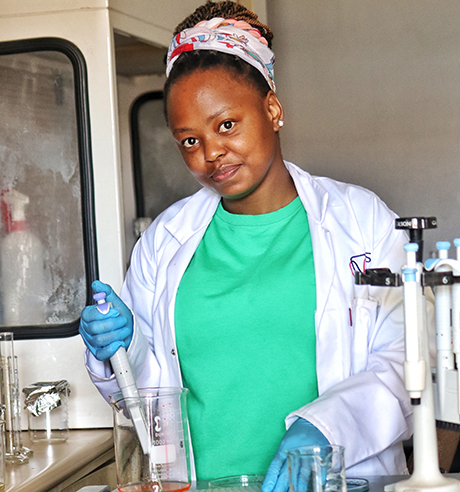19 December 2022
|
Story Nonsindiso Qwabe
|
Photo Supplied
 Growing up, Tshepiso Letaoana, an MSc student and facilitator in the Faculty of Natural and Agricultural Sciences never imagined that one day she would be conducting research on a fruit she grew up playing with.
Growing up, Tshepiso Letaoana, an MSc student and facilitator in the Faculty of Natural and Agricultural Sciences never imagined that one day she would be conducting research on a fruit she grew up playing with.
In English, it is called quince, but you probably grew up calling it kwepere. Does this ring a bell? Kwepere – scientific name Cydonia oblonga – is a bright yellow shrub fruit that looks like a cross between an apple
and a pear. When you look past its rather unappealing characteristics, such as being nearly inedible when raw, quince is delightfully surprising. Its flavour is delicately sweet when stewed, and its aroma is reminiscent of vanilla and oranges. When
cooked, the fruit’s pale-yellow colour changes to a lovely rose. It preserves a distinctive aromatic smell and has a slightly sour taste when ripe; it is often used in jams, marmalades, and alcoholic beverages, to mention a few. Although found
in many backyards in Qwaqwa and around the country, it is an ancient fruit native to various parts of Asia and the Mediterranean.
An aroma that can be sensed from a mile away
Growing up, Tshepiso Letaoana, an MSc student and facilitator in the Faculty of Natural and Agricultural Sciences never imagined that one day she would be conducting research on a fruit she grew up playing with. Inspired by Prof Anofi Ashafa,
Associate Professor in the Department of Plant Sciences,
who observed that during each fruiting season quince would either end up rotting while hanging on the trees or dropping to the ground, rendering it unusable and inedible, Letaoana embarked on research to learn more about the fruit for her honours
research.
“As a young girl, our neighbour had a garden full of quince trees, and I always looked forward to harvest season because the smell and taste were so exhilarating. I had no idea that it had so many benefits, I was just eating it for the delicacy
experience. When I embarked on my research journey, I got to learn that it contains good antioxidant and antidiabetic properties. Conducting this research has opened me up to the history of the folklore and the use of the plant in the olden days.”
Giving quince a chance to reach fruit market shelves
Currently, on her master’s journey, she has uncovered that the main culprit causing the fruit to rot are pathogens that attack and lead to deterioration as well as spoilage of the fruit. Using the plants’ own parts, she aims to formulate antifungals
that will mitigate or eradicate these pathogens attacking the fruit, so that it will have a chance to reach the shelves in fruit markets.
“I hope I will also get the opportunity to store my research findings in the university’s archives
so that the information can be available to other communities and can be utilised by future generations. We also hope for a possible development of
Cydonia oblonga extracts into antimicrobial spraying agents that can be used by supermarkets.
This research will help educate the community of Maluti-a-Phofung about cost-effective methods they can use to overcome the challenges they face in dealing with the pathogens and taking care of their
kwepere as well as other fruit-bearing trees.
With further research, this could also lead to the creation of job opportunities should one pursue the cultivation of these trees in order to supply the fruits to local supermarkets.”